Chapter 19
Newton’s Slingshot

Tinker Newton’s laws with rubber-band power.
Kids in Timor love to make and shoot slingshots. As I watch them pull the rubber bands back and set the stone to sailing, I always think of Uncle Isaac Newton’s laws of motion. Here’s a fun little set of experiments we developed for teachers to demonstrate those laws in the context of slingshots.
Gather stuff
- Forked branch
- Rubber bands, maybe 20
- Piece of sturdy cloth
- Loop of yarn or a stick to scratch a circle on the ground
- Rocks: two the same, one big and one small
Gather tools
- Saw
- Scissors


Tinker
Make a slingshot! Cut a nice sturdy forked branch from a healthy tree. Get a bunch of rubber bands and a piece of cloth.

We used these skinny rubber bands in sets of four, hitching them together with that knot where you put one side of the loop through the other loop and back through itself. Use the same one to tie the rubber bands to the stick, preparing it on your fingers and then sliding it on the ends.
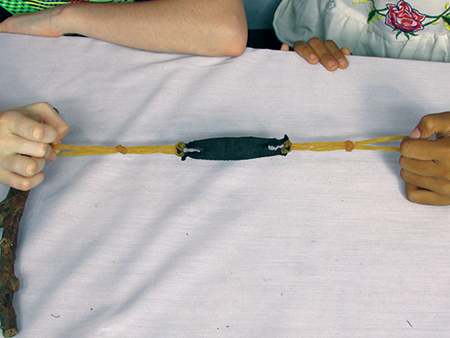
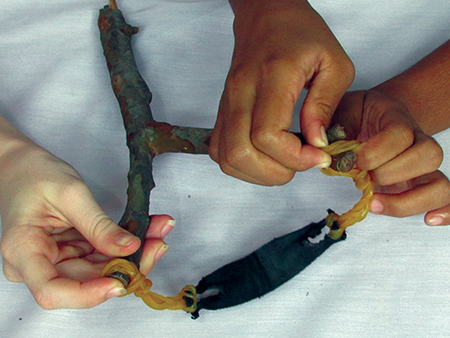

Uncle Newton wrote three laws of motion. We’ll examine them all, but it so happens that the first one is the most subtle and the third one the most obvious, so we’ll do them in reverse order.
Newton’s Third Law
Put a rock in your slingshot and draw it back. Don’t shoot. Feel the forces on your two arms.

What’s Going On?
There you go: it’s the third law:
- For every action there is an equal and opposite reaction.
By action, Uncle Newton meant force. You want to give a rock a force forward, so it flies forward and hits something, right? The hand holding the slingshot is exerting a force forward, right?2
But now look at the back hand, the one holding the rock. Its force is directed backward. The forces are equal, as I’m sure you can appreciate; you’re pulling forward with the same force as you’re pulling back.
This, my friends, is always, always the case. Any force you find has another force opposing it:
- Gravity pulls a book down onto the table, and the table pushes up on the book.
- You push against a wall and the wall pushes back on you.
- The back wheel of your bike pushes back on the road as you pedal, and the road pushes forward on the bike.
- The propeller on an airplane or boat pushes the air or water back, and the air or water pushes the airplane or boat forward.
You can already see the problem when physics textbooks speak of “action-reaction forces,” as if they’re some special subset. It’s all of them, buddy, and don’t you forget it: forces always come in pairs. Now on to the second law.
Newton’s Second Law
F=ma
Any questions? Usually the law is stated with mathematics like this, because everything we’ll do in the following long-winded, highly articulated, ultra-analyzed tinkering is contained in that equation. Of course, for you to understand it, you have to know the mathematics called algebra. If you aren’t fluent in algebra you won’t fully get it yet. Not to worry; read on.
First off, the three letters represent three variables: F is force, m is mass, and a is acceleration. These are three quantities that can vary in a given motion situation, and they are oh-so intimately related. The m and the a are right next to each other, and that means they’re multiplied in the equation, so you could also write it F=m x a or F=m*a.
We’ll do three pairs of slingshot shootings here, each time holding one of those variables constant and seeing what happens in the relationship between the other two.
#1. Launch the big rock and then the little rock, pulling the slingshot back to the same distance and keeping it level. We used 25 centimeters. You may want to practice launching the big rock a few times; it’s not as easy as the small rock.
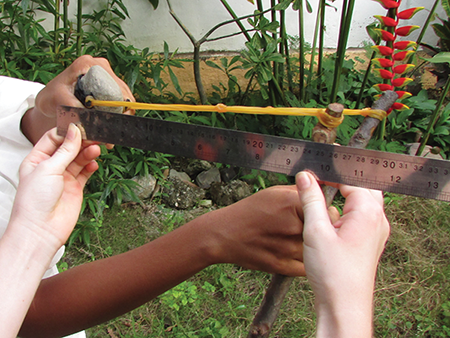
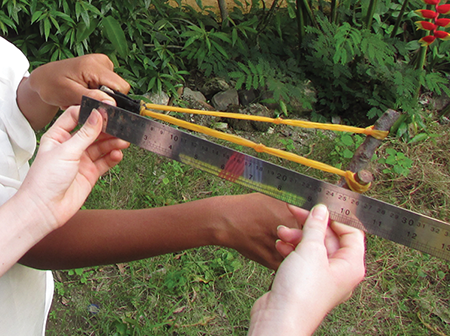
We saw the small rock go much farther than the big rock.
#2. Get out the two rocks of the same size. Shoot the first one by pulling back on the slingshot just a bit, and the second one by pulling back a lot. Keep the angle of the slingshot as steady as you can.


I’ll bet you saw the first rock go a short distance and the second one go farther.
#3. Now make a circle on the ground, either with a loop of yarn or rope, or just scratching it in the dirt. (Ours is a bit skinny—you can barely see it beside the pumpkin vine.) Shoot the big and small rocks until you hit the circle. As you do this, note how far you had to pull the slingshot back for each of the rocks.

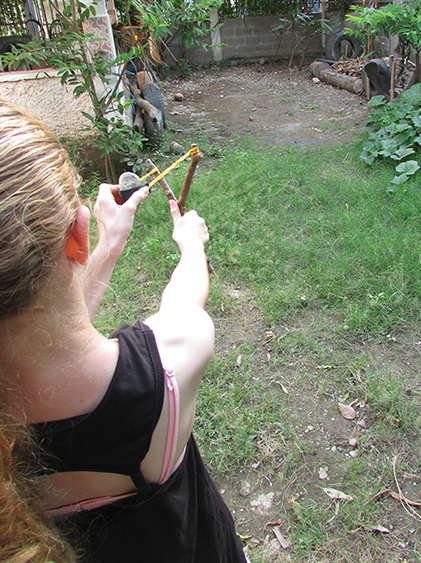
You don’t see it in the photos, but Zaya had to pull the big one back farther to get it into the circle.
(I hope you don’t get tired of me telling you this, but please don’t trust us on this. I mean really; you don’t even know us! We could be lying straight-faced to you. What’s more, this is so easy to try. So do it and place your confidence squarely in yourself, not in these two girls of questionable motive…)
What’s Going On?
Uncle Newton’s second law lays out the relation between three variables. Force is a push or a pull, mass is a lot like weight—that is, how heavy something is—and acceleration is how fast the speed of something is changing.
Acceleration is the complicated one. Speed is easier—that’s how fast something is going. Acceleration is the change in speed. So when you put your foot down on the accelerator, you start to go faster and faster, and you’re accelerating. And when you hit the brake, you start to go slower and slower, so you’re accelerating again, this time with a negative acceleration.
But when you’re doing 65 miles per hour down the freeway, needle steady on the speedometer, radio blasting, breeze blowing back your hair, not a care in the world, your acceleration is…zero. And then, when you get pulled over by a cop because it was a 50-mile-per-hour zone, once you come to a stop your acceleration is again zero. Anytime your speed is constant, no matter what the value is, your acceleration is zero.
Now let’s look at the relations we just saw one by one. In #1, the force was constant. The rubber bands give force depending on how far you pull them back, so if you pulled the slingshot back the same distance both times, it gave a constant force to the big and the small rocks. And if your rocks sailed like ours did, the small one went much farther.
How far the rock went is sort of a measure of acceleration. It’s really hard to measure otherwise, but all else being equal, the rock that had a higher acceleration in the slingshot is going to go farther. So this is an easy way to compare accelerations. In physics we say the distance is proportional to the acceleration. So this means the big rock had a smaller acceleration than the small rock.
So there is the first relation:
- 1. When force is constant, the bigger the mass, the smaller the acceleration.
In #2, the mass was constant; the two rocks weighed almost the same. You gave one a big force by pulling the rubber band back a lot and the other one a small force by pulling the rubber band back a little. If yours sailed like ours did, the one getting the larger force went far and the one getting the small force didn’t go as far.
That’s our second relation:
- 2. When mass is constant, the bigger the force, the bigger the acceleration.
Finally, in #3 acceleration was constant. You shot them to land at the same distance, so their acceleration had to be more or less the same. If your results were like ours, it took a larger force to give that acceleration to the bigger rock—that is, you had to pull the slingshot back farther. You had to pull the slingshot back only a short distance to give the smaller rock that acceleration.
The final relation then is this:
- 3. When acceleration is constant, the bigger the mass, the bigger the force.
Again, all that verbiage is contained in the elegant little equation F=ma. Once you understand algebra like this and even higher math, you can recognize one of the great wonders of the universe that many scientists have marveled at: how does this language called mathematics fit so well with our observations of natural phenomena? I’ll leave you marveling on that and wrap up this second law.
All those relations I wrote can be written the other way round as well. You could call it the vice versa form:
- 1. With a constant force, the smaller the mass, the bigger the acceleration.
- 2. With a constant mass, the smaller the force, the smaller the acceleration.
- 3. With a constant acceleration, the smaller the mass, the smaller the force.
You’ll notice that in the second two relations, the variables go together: the bigger, the bigger; the smaller, the smaller. This is called direct proportion. Only the first one has variables in what we call an inverse proportion: the bigger, the smaller; the smaller, the bigger.
This all makes perfect sense, and I think if you had made predictions of the results of this experiment, you would have nailed most of them. Here are some examples from daily life that follow those rules and just make sense if you think about them.
- A big truck (big mass) is going to require a bigger engine (bigger force) to reach a certain (constant) acceleration than a motorcycle (small mass).
- If two identical cars (constant mass) start off together, the one that wants to reach higher acceleration in a certain distance will need a greater force.
- If you give the same push (constant force) to two kids on tricycles, one big husky kid and one little skinny kid, the skinny one will take off faster (higher acceleration).
Newton’s First Law
Okay, ready? Here it goes: grab the slingshot and shoot a rock, any rock. (Don’t hit anything delicate!) Watch what happens.
What’s Going On?
Did it come to a stop in the end? Of course it did! That just makes sense right? If it hadn’t stopped you’d have freaked.
Around 2,360 years ago, Aristotle wrote down what we all know full well: objects in motion tend to come to rest. Even more obvious than that, he wrote that objects at rest tend to stay at rest. End of story, right?
Well, actually, no. Some 1,700 years later Uncle Newton made several interesting observations, along the following lines:
- A slingshot rock does not come to rest until it hits something. As long as it doesn’t hit anything, it keeps on flying.
- The moon doesn’t seem to have a rocket powering it to orbit around the earth, nor does the earth seem to have a rocket powering it around the sun. It seems celestial bodies just tend to move forever without any added force.
- If you roll one marble such that it smashes into a row of marbles, it will stop and the marble on the end will take off rolling with about the same speed. It will often keep rolling until it hits something.
These and various other observations led Uncle Newton to formulate his law quite a bit differently than Aristotle’s. Here it is:
- Objects in motion tend to stay in motion, until they receive a force to change that motion or bring them to rest. Objects at rest tend to stay at rest, until they receive a force that sets them in motion.
Today you can see videos on the Internet in which astronauts in orbiting laboratories pass things to each other with the slightest flick of a finger. The object heads slowly across the spacecraft until it arrives at the other side. Had Uncle Newton seen such footage, he may have come up with his law even earlier (he probably didn’t have Wi-Fi). It’s all obvious when you escape the earth’s gravity.
So that force pulling everything down messes with our observations. Even when something round is rolling on the ground so it’s got no sliding friction, it hits little bumps and gets friction from the air, and in the end always encounters enough forces to bring it to a stop. We hardly get to see any examples of an object in motion staying in motion. We can forgive old Aristotle: he had so few examples to observe.
That was the brilliance of Uncle Newton. He saw that the moon and planets were the norm—moving on and on without stopping—and that everything here on Earth was getting a stopping force when gravity brought it in contact with Earth.
You can see this law in action in situations of super low friction, like the rolling marbles, or an air hockey table, or something heavy sliding on ice, but the best example of objects staying in motion are projectiles. The farther you shoot them, the farther they go, and if you shoot one far enough, the earth’s surface will fall away due to its curvature and the object will end up falling around the earth indefinitely because it never gets the stopping force. That is the situation of a satellite.
And those are Uncle Newton’s three laws of motion! Next time you throw, hit, or kick something into motion, think about how the forces relate to these laws. It doesn’t matter what hemisphere you’re in, or even what planet or galaxy; they apply everywhere!
